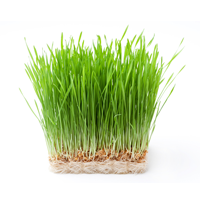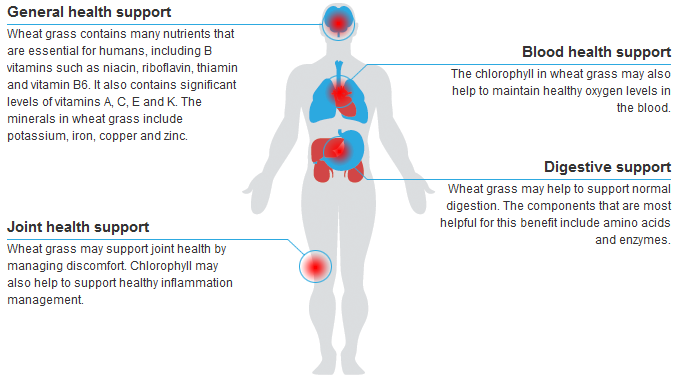 Wheat grass is the stalk of the common wheat plant, known scientifically as Triticum aestivum. It is typically sold as a dietary supplement, usually as a juice or powder. Topical applications that contain wheat grass are also commonly available, including creams, gels, lotions, and sprays.
Wheat grass is the stalk of the common wheat plant, known scientifically as Triticum aestivum. It is typically sold as a dietary supplement, usually as a juice or powder. Topical applications that contain wheat grass are also commonly available, including creams, gels, lotions, and sprays.
The production of commercial wheat grass typically requires growing the wheat plants slowly for 200 days, typically from winter to early spring. They are usually harvested when the nutritional content is at its highest level, which is after the wheat plants sprout but before the seeds form. Wheat grass therefore doesn’t contain any gluten since it doesn’t have seeds.
The cultivation of wheat as a grain crop is more than 5,000 years old and may have been practiced by ancient Mesopotamian civilizations. The ancient Egyptians also used wheat grass for health purposes. The dietary use of wheat grass in the Western world is relatively recent, dating only to about the 1930s. Cans of powdered wheat grass have been commercially available in North America since 1940.
Wheat grass contains many nutrients that are essential for humans. It is also high in chlorophyll, which provides many health benefits, but low in protein, so wheat grass requires additional protein to serve as a complete food source.
The most common use of wheat grass is for general nutrition. Additional benefits of wheat grass include support for the digestive system, joint health, and blood oxygenation.
Wheat grass contains many nutrients that are essential for humans, including B vitamins such as niacin, riboflavin, thiamin, and vitamin B6. It also contains significant levels of vitamins A, C, E and K. The minerals in wheat grass include potassium, iron, copper, and zinc.
Wheat grass may support joint health by managing discomfort. Chlorophyll may also help to support healthy inflammation management.
The chlorophyll in wheat grass may also help to maintain healthy oxygen levels in the blood.
Wheat grass may help to support normal digestion. The components that are most helpful for this benefit include amino acids and enzymes.

Poor nutrition is one of the most significant reasons for taking wheat grass supplements. This is most common in calorie-restricted diets, where it’s important to add nutrients without adding calories. Digestive signs that may benefit from wheat grass include heartburn, indigestion, irritable bowels, and ulcers. You may need wheat grass if you have blood conditions characterized by low oxygen levels. The chlorophyll in wheat grass may also help with joint conditions that cause discomfort.
Triticum aestivum, wheatgrass

However before we go any further, you need to remember that although juicing is a good start towards general health, it’s not the best way of ensuring that you get the right amount of nutrients every day. This is because of mineral deficiencies i...

Heart Health Support Barley Grass Background and Benefits Barley is a species of grass known scientifically as Hordeum vulgare. It is typically cultivated as a cereal crop and is especially popular Tibetan cuisine. Barley grain is often used to make bread, and it is also a common filler in soups ...

Support for Cellular Health Spirulina Background and Benefits Spirulina is a type of bacteria that can perform photosynthesis, which is known scientifically as cyanobacteria. It includes two species in the Arthrospira genus, Arthrospira maxima and Arthrospira platensis. Spirulina is so named beca...
Shipping calculated at checkout